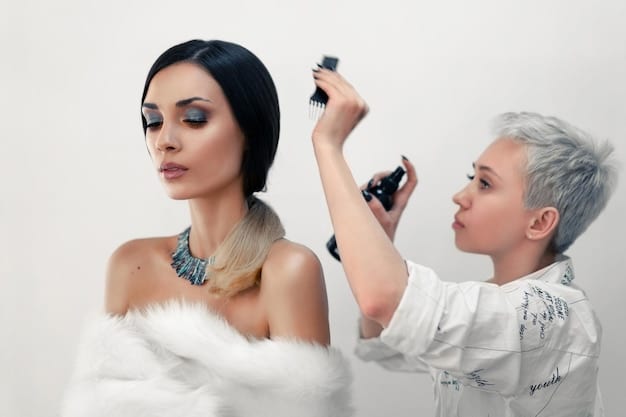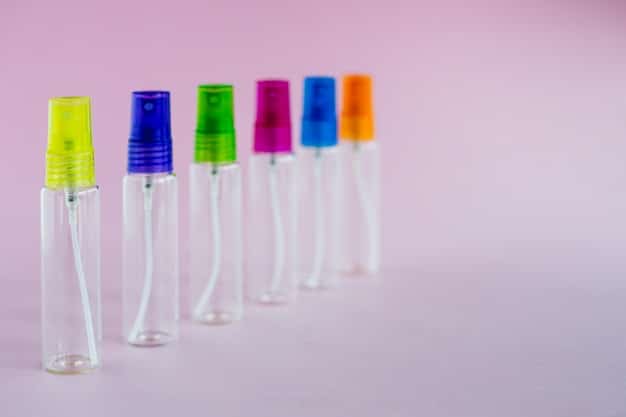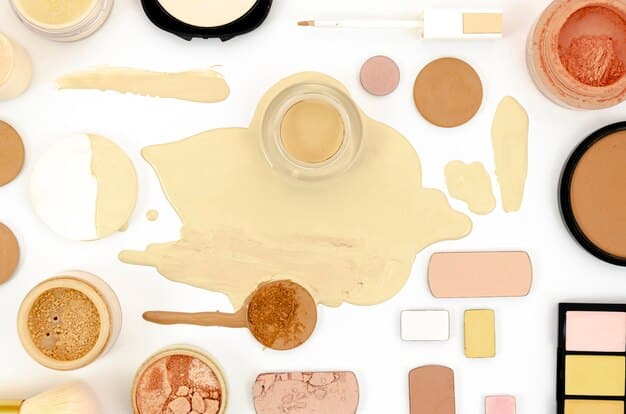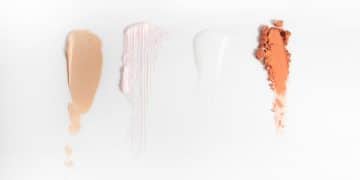Setting Spray Showdown: Keep Makeup Flawless All Day

Anúncios
Setting sprays are essential for extending makeup wear, providing a protective barrier against environmental factors and ensuring a fresh, long-lasting finish throughout the day.
In the dynamic world of cosmetics, achieving a flawless, long-lasting look is a perennial pursuit for makeup enthusiasts and professionals alike. The quest for makeup longevity often leads to the discovery of unsung heroes, and among them, the setting spray stands out as a fundamental element. This comprehensive Setting Spray Showdown: Which Formula Will Keep Your Makeup in Place All Day? aims to demystify the science behind these transformative products, comparing various formulations and guiding you toward the ideal choice for your specific needs, ensuring your artistry remains impeccable from dawn till dusk.
Anúncios
The science behind setting sprays: more than just water
Setting sprays have revolutionized makeup application, moving beyond simple hydration to offer genuine staying power. Understanding their fundamental composition reveals how they achieve this feat. These sprays typically consist of a blend of polymers, film-formers, and humectants, each playing a crucial role in creating a lasting barrier on the skin.
Polymers, such as PVP (Polyvinylpyrrolidone) or VP/VA Copolymer, are the backbone of most setting sprays. When sprayed onto the face, these microscopic plastic-like molecules form a thin, flexible, and invisible film over the makeup. This film acts as a protective shield, locking in all layers of makeup underneath, from foundation to powder and blush. The flexibility of this film is key; it allows for natural facial movements without cracking or flaking.
Film-formers and their benefits
Film-formers work in tandem with polymers to enhance the spray’s efficacy. Ingredients like acrylates copolymer contribute to the creation of a mesh-like structure on the skin. This structure not only adheres to makeup particles but also creates a resistance against external factors like humidity, sweat, and friction. Unlike hairspray, which is designed for rigid hold, a good setting spray’s film is breathable and comfortable, preventing a stiff or tight feeling on the skin.
Anúncios
- Enhanced Durability: Creates a protective layer that significantly extends makeup wear.
- Melting Effect: Helps powders melt into the skin, preventing a cakey appearance.
- Transfer Resistance: Reduces the likelihood of makeup transferring onto clothes or masks.
- Environmental Shield: Provides a barrier against pollutants and humidity.
Humectants, such as glycerin or hyaluronic acid, are often included to prevent the film from feeling dry or tight. These ingredients attract and retain moisture from the air, maintaining a comfortable and somewhat flexible finish. This dual action—setting and hydrating—is what elevates setting sprays from a simple final step to an integral part of a long-lasting makeup routine. The combined effect of these ingredients ensures that your makeup not only stays put but also looks fresh and natural throughout the day.
Choosing the right setting spray for your skin type
Selecting the ideal setting spray goes beyond simply wanting makeup to last; it truly hinges on understanding your skin’s unique needs. Just as you choose foundations and primers based on whether your skin is oily, dry, combination, or sensitive, the same discerning approach should be applied to setting sprays. A formula designed for oily skin, for example, could leave dry skin feeling tight and uncomfortable, while a hydrating spray might exacerbate shine on an already oily complexion.
For those with oily or combination skin, the primary concern is often managing excess sebum production and preventing makeup from sliding or creasing. Setting sprays formulated for these skin types typically incorporate mattifying agents like silica or absorbent powders. These ingredients work to control shine, visibly reduce the appearance of pores, and create a soft-focus finish. They often contain alcohol to help the product dry quickly and to dissolve oils, though modern formulations are increasingly focusing on non-drying alternatives that still deliver powerful oil control without stripping the skin.
Conversely, dry or dehydrated skin requires a setting spray that prioritizes hydration and comfort. These formulations are rich in humectants such as glycerin, hyaluronic acid, or plant extracts like rosewater or aloe vera. Their purpose is to lock in moisture, prevent makeup from looking cakey or settling into fine lines, and impart a dewy, radiant finish. Such sprays help to “melt” powders into the skin, creating a more natural and less textured appearance. They can also provide a refreshing boost throughout the day, alleviating any feeling of dryness.

Specific considerations for sensitive and mature skin
Sensitive skin types need to be particularly cautious about ingredients. Look for setting sprays that are alcohol-free, fragrance-free, and hypoallergenic. Formulations boasting soothing ingredients like chamomile, green tea extract, or niacinamide can also be beneficial in reducing potential irritation. Patch testing a new spray on a small area of your skin before full application is always a wise precaution.
Mature skin often faces challenges such as dryness, fine lines, and a desire for a more youthful, supple look. Setting sprays for mature skin should focus on hydration, anti-aging properties, and a non-drying finish. Sprays with luminosity or a radiant finish can help soften the appearance of lines and add a healthy glow, avoiding anything too mattifying that might accentuate dryness. Understanding your skin’s specific behavior throughout the day will ultimately guide you to the perfect setting spray match, ensuring not just longevity but also a comfortable and flattering finish.
Application techniques for maximum staying power
The effectiveness of a setting spray isn’t solely dependent on its formula; proper application technique plays an equally critical role in ensuring makeup remains flawless. Many users make the mistake of simply spritzing haphazardly, but a strategic approach can significantly enhance its “locking” capabilities. The goal is to create an even, fine mist that coats the entire face without drenching the makeup or disturbing its layers.
Begin by holding the bottle at arm’s length, typically about 8-12 inches (20-30 cm) away from your face. This distance is crucial for achieving a wide, diffused spray pattern rather than a concentrated stream. Closing your eyes and mouth is essential to prevent product getting into them. A common method for even coverage is the “X” and “T” technique. First, spray in an “X” shape across your face, starting from one forehead temple, going diagonally across your face to the opposite jawline, and then repeating from the other temple to the other jawline. Immediately follow this with a “T” shape, spraying across your forehead and then down the bridge of your nose and chin.
After applying the spray, resist the urge to touch your face or fan it vigorously. Allow the spray to air dry naturally. This allows the film-forming polymers to settle and create that invisible, flexible barrier. If you’re in a hurry, a gentle, light fanning motion might be acceptable, but aggressive fanning can disrupt the setting process or even push the product unevenly, leading to patchiness. Remember, less is often more; a fine, even layer is more effective than an oversaturated face, which can actually cause makeup to run.
Advanced tips for enhanced longevity
- Layering Techniques: For exceptionally long wear or in challenging conditions, consider applying a light mist of setting spray *before* foundation, on top of primer. This creates an initial gripping layer. Then, apply your makeup as usual and finish with another application of setting spray.
- Targeted Application: If you have specific areas that tend to crease or fade (e.g., under-eye concealer, smile lines), a very light, targeted spray can offer extra reinforcement. However, be cautious not to over-saturate.
- Dabbing, Not Rubbing: If you need to blot excess oil throughout the day, gently press a clean tissue or blotting paper onto your skin instead of rubbing. This helps absorb oil without disturbing the set makeup.
An often-overlooked tip is to allow sufficient time for each makeup layer to settle before moving to the next. While a setting spray is the final step, letting products like liquid foundation or concealer absorb properly helps create a more unified canvas for the spray to adhere to. By incorporating these meticulous application techniques, your chosen setting spray will perform at its peak, providing truly steadfast makeup that withstands the rigors of your day.
Comparing popular setting spray formulations: a deep dive
The market is flooded with setting sprays, each promising to be the ultimate solution for makeup longevity. However, their efficacy largely depends on their specific formulation and the science behind their claims. To truly understand which formula might be your ultimate hero, a closer look at the differing types and their signature ingredients is essential. We can broadly categorize them into mattifying, hydrating, and natural/hybrid formulations.
Mattifying setting sprays are powerhouses for those battling excess shine and oil. Brands like Urban Decay’s De-Slick Makeup Setting Spray and NYX Professional Makeup’s Matte Finish Setting Spray often feature ingredients like silica or various copolymers (e.g., acrylates copolymer, PVP) that are highly effective at absorbing sebum and creating a soft, velvety finish. These sprays work by forming a permeable film that allows sweat to escape but prevents oil from breaking through and disrupting makeup pigments. The key is to find a mattifying spray that controls shine without leaving the skin feeling tight or flaky, a common pitfall in older formulations containing high concentrations of drying alcohols.

On the opposite end of the spectrum are hydrating or dewy setting sprays, exemplified by products like MAC Fix+ or Morphe Continuous Setting Mist. These are typically alcohol-free and packed with humectants such as glycerin, hyaluronic acid, and nourishing extracts (e.g., green tea, cucumber, rosewater). Their primary function is to infuse moisture into the skin, prevent makeup from looking dry or powdery, and impart a fresh, luminous glow. While they may not offer the same oil control as their mattifying counterparts, they excel at melding makeup seamlessly with the skin, reducing patchiness and enhancing a natural, radiant finish. They are particularly favored by those with dry, normal, or mature skin, or anyone seeking a healthier, less flat makeup look.
Hybrid and long-wear formulas
Beyond these two main categories, there is a growing segment of hybrid and long-wear formulas that attempt to offer the best of both worlds. Brands like Charlotte Tilbury’s Airbrush Flawless Setting Spray or Milk Makeup’s Hydro Grip Setting Spray often contain a sophisticated blend of film-formers, hydrating agents, and sometimes even pore-blurring or skin-caring ingredients. These formulas aim to provide exceptional longevity, resisting transfer and fading, while still offering a comfortable feel and a natural finish that isn’t excessively matte or dewy. They often boast advanced polymer technologies designed for extreme conditions or extended wear, making them popular for events or long days.
- Urban Decay All Nighter Setting Spray: Known for extreme longevity and transfer resistance, suitable for most skin types, slightly mattifying.
- MAC Prep + Prime Fix+: Hydrating and refreshing, excellent for meld powders and adding dewiness, minimal long-wear benefits on its own.
- Charlotte Tilbury Airbrush Flawless Setting Spray: Promises 16-hour wear, combines setting power with a soft-focus finish, popular for special occasions.
- Milk Makeup Hydro Grip Setting Spray: Unique gel-based primer/setting spray hybrid, creates a sticky base for makeup adhesion, offers impressive hold.
- NYX Professional Makeup Matte Finish Setting Spray: Affordable and effective for oil control, delivers a true matte finish.
The ultimate choice in this showdown hinges on individual preferences: do you prioritize intense oil control, a dewy glow, or an all-encompassing, comfortable long-wear solution? Understanding the dominant ingredients and intended effects of each type of spray will empower you to make an informed decision that truly aligns with your makeup goals and skin type.
Addressing common setting spray myths and misconceptions
Setting sprays have been a staple in makeup routines for years, yet they remain shrouded in various myths and misconceptions. Clarifying these can help users harness their full potential and avoid common pitfalls. One prevalent myth is that “setting spray is just hairspray for your face.” While both contain similar film-forming polymers, their formulations are vastly different. Hairspray contains ingredients specifically designed for rigid hold on hair, which can be irritating, drying, and pore-clogging when applied to the delicate facial skin. Setting sprays, conversely, are formulated to be breathable, comfortable, and skin-safe, creating a flexible, invisible barrier.
Another misconception is that “all setting sprays are the same.” As explored, this couldn’t be further from the truth. There’s a wide array of formulations catering to different skin types and desired finishes – from mattifying and oil-controlling to hydrating and dewy. Using a mattifying spray on dry skin, or a hydrating one on oily skin, can lead to unsatisfactory results, reinforcing the importance of choosing based on individual needs rather than a one-size-fits-all approach. Their varying polymer concentrations and additional ingredients dictate their specific effects and longevity.
A common belief is that “setting spray makes makeup waterproof.” While many setting sprays enhance makeup’s resistance to water, sweat, and humidity, very few are truly “waterproof” in the sense that they will withstand prolonged submersion or heavy rubbing. They significantly improve durability and reduce transfer, but they won’t make your makeup indestructible against a torrential downpour or vigorous swimming. For extreme water resistance, specialized waterproof makeup products are often required in conjunction with a robust setting spray.
Debunking further myths
- “Setting spray is a substitute for primer.” While some hybrid products exist, traditional setting spray is applied *after* makeup, whereas primer creates a base *before* foundation. They serve different, complementary purposes; primer creates an ideal canvas, while spray locks in the finished look.
- “You need to use a lot for it to work.” Over-saturating your face can actually be counterproductive. Too much product can make makeup run, feel heavy, or take too long to dry. A fine, even mist is far more effective than drenching your skin, as it allows the polymers to form an optimal, breathable film.
- “Setting spray causes breakouts.” While any product can potentially cause breakouts if it contains an ingredient your skin is sensitive to or if not properly cleansed, setting sprays themselves are not inherently pore-clogging. Non-comedogenic formulations are widely available, and proper nightly removal of all makeup (including setting spray) is key to maintaining clear skin.
By understanding these distinctions, consumers can make more informed choices and apply setting sprays more effectively, unlocking their true potential for extending makeup wear and maintaining a fresh, flawless complexion throughout the day, unburdened by misleading notions.
Beyond makeup: unexpected uses for your setting spray
While primarily lauded for its ability to lock makeup in place, a versatile setting spray can offer a surprising range of applications that go beyond the traditional final spritz. Its inherent properties – particularly its film-forming capabilities and often hydrating components – make it a handy tool for various beauty hacks, transforming its role from a single-purpose product to a multi-functional secret weapon in your beauty arsenal. Exploring these alternative uses can maximize the value of your setting spray and simplify your routine.
One popular alternative use is to intensify eyeshadows and pigments. When a shimmery or metallic eyeshadow is applied dry, its full vibrancy often remains untapped. Lightly misting your eyeshadow brush with setting spray before dipping it into a pigment can dramatically enhance its color payoff and create a more metallic, foil-like finish. This technique not only makes the shadow appear more vibrant but also helps it adhere better to the eyelid, reducing fallout and creasing, especially with loose pigments or glitter.
Setting spray can also revive dry or cakey makeup. Throughout the day, particularly in dry environments or after touch-ups, makeup can sometimes look powdery or settle into fine lines. A light mist of a hydrating setting spray can help to “melt” these layers together, refreshing your complexion and restoring a more natural, seamless finish without needing to reapply everything. This is especially useful for blending blush or bronzer that might appear too harsh, allowing them to fuse more naturally with your foundation.
Creative applications and problem-solving
- Transforming Powder Products: Use setting spray to convert powder eyeshadows into eyeliners. Dip a thin, angled brush into your preferred eyeshadow, then mist the brush with setting spray. This creates a liquid eyeliner texture with custom colors and improved longevity.
- Extending Eyebrow Products: For unruly brows or to make brow pencils/powders last longer, lightly mist a spoolie brush with setting spray and comb through your brows after applying product. This helps to set the hairs and the product in place.
- Reviving Makeup Brushes: If a makeup brush feels a little stiff or if you need to quickly clean off excess product between uses (especially for eyeshadows), a quick spritz of setting spray on a tissue, followed by wiping the brush, can refresh it temporarily, allowing for seamless color transitions.
- Spot Setting Concealer: For areas prone to creasing, like under the eyes, apply a tiny amount of setting spray onto a beauty sponge or fingertip and gently press it over the freshly applied concealer. This helps to lock it down before it settles into lines.
From intensifying color to refreshing tired skin, a high-quality setting spray proves its versatility far beyond just the final step. These unexpected applications make it an indispensable product, demonstrating that sometimes, the best beauty tools are those that can adapt and serve multiple purposes, offering both efficacy and convenience in your daily routine.
The future of setting sprays: innovation and trends
The beauty industry is perpetually evolving, and setting sprays are no exception. Far from being a static product category, these formulas are continuously subject to scientific advancements and shifting consumer demands. The future of setting sprays is poised to deliver even more sophisticated, multi-functional, and skin-centric solutions, reflecting a broader trend towards skincare-infused makeup and sustainable practices. Understanding these emerging innovations can provide a glimpse into the next generation of makeup longevity.
One major trend anticipated is the deeper integration of skincare benefits into setting spray formulations. While some sprays already boast humectants like hyaluronic acid, future iterations are likely to include potent antioxidants (e.g., Vitamin C, green tea extract), prebiotics to support the skin microbiome, and even targeted treatments for specific concerns like anti-aging peptides or anti-pollution complexes. This evolution blurs the lines between makeup and skincare, offering users not just extended wear but also enhanced skin health with every application. The consumer desire for products that “do more” is a powerful driving force behind this holistic approach.
Another significant area of innovation lies in the development of more advanced, breathable film-forming technologies. Scientists are constantly researching polymers that offer superior longevity and transfer-resistance without feeling heavy or compromising skin comfort. This includes micro-encapsulation techniques that slowly release active ingredients, or novel film-formers that adapt to environmental conditions, providing optimal hold whether it’s humid or dry. These advancements aim to deliver truly “bulletproof” makeup that feels weightless and natural.
Sustainable and personalized solutions
Sustainability is also set to play a larger role. We can expect to see more eco-friendly packaging (refillable options, recycled materials), ethically sourced ingredients, and formulations that are biodegradable. Brands are increasingly recognizing the consumer demand for transparency and environmental responsibility, which will translate into more conscious product development in the setting spray market. This focus on sustainability will extend beyond the product itself to its entire lifecycle, from sourcing to disposal.
Finally, personalization is an emerging frontier. While currently somewhat niche, future setting sprays might leverage AI or diagnostic tools to recommend customized formulas based on individual skin type, climate, and lifestyle. Imagine a spray that adjusts its mattifying or hydrating properties based on real-time weather data, or one formulated specifically for those who wear protective masks for extended periods. This level of tailored beauty promises to unlock unprecedented levels of effectiveness and user satisfaction, solidifying the setting spray’s indispensable role in the modern beauty routine.
| Key Point | Brief Description |
|---|---|
| ✨ Formula Variety | Sprays come in mattifying, hydrating, and hybrid types to suit different skin needs. |
| 💧 Proper Application | Distance and “X” and “T” patterns ensure even, effective coverage. |
| 💡 Beyond Setting | Can intensify eyeshadow, refresh makeup, and set brows. |
| 🧪 Future Trends | Expect more skincare integration and sustainable options. |
Frequently asked questions about setting sprays
While primarily designed for makeup, a hydrating setting spray can offer a refreshing boost to bare skin, especially if it contains humectants like hyaluronic acid. It won’t “set” anything, but it can provide light hydration or a dewy glow. It’s generally not recommended for true makeup longevity without a base.
Setting powder is a dry product used to absorb oil, mattify, and lock liquid/cream makeup in place, often applied with a brush or puff. Setting spray is a liquid mist that forms a thin film over makeup, reducing transfer and enhancing longevity, and can also help powders blend seamlessly for a more natural finish.
Generally, one application of setting spray after your full makeup routine is sufficient for all-day wear. Reapplication is usually not necessary unless you’re in extremely demanding conditions, have very oily skin, or are refreshing your makeup after blotting. Over-applying can lead to a heavy or sticky feeling.
A good quality setting spray should dry down without leaving a sticky residue. Stickiness often occurs if too much product is applied, if the spray contains specific ingredients like high concentrations of glycerin or certain film-formers, or if it hasn’t fully dried. Allow it to air dry completely for best results.
While some specialized “setting primer” hybrids exist, traditional setting sprays are not designed to be primers. Primers create a smooth base for makeup, often addressing texture or oil control. Setting sprays are meant to lock in finished makeup. Using a regular setting spray as a primer may not offer the same benefits or longevity for your initial makeup application.
Conclusion
In the dynamic realm of cosmetics, the setting spray has firmly established itself as an indispensable tool for achieving lasting makeup artistry. This exploration has revealed that these aren’t mere mists, but sophisticated formulations leveraging polymers and humectants to create a protective yet flexible barrier. From selecting the ideal spray for specific skin types – whether oily, dry, sensitive, or mature – to mastering nuanced application techniques, every detail plays a crucial role in maximizing longevity. Dispelling common myths underscores the importance of informed choices, while the unexpected versatility of these sprays highlights their potential beyond basic setting. As the beauty industry continues its march towards innovation, integrating skincare benefits and sustainable practices, setting sprays are poised to evolve further, ensuring that our quest for flawless, all-day makeup remains not just a dream, but a consistent reality. Choosing the right formula, coupled with precise application, truly empowers you to defy fading and creasing, maintaining a fresh and perfected complexion from morning till night.





